The Ultrastar SSD400M is Hitachi’s effort to provide a serious contender in the burgeoning eMLC enterprise SSD space. The SSD400M offers all the pedigree that enterprise buyers could want, including not just Hitachi’s longstanding leadership in the storage industry, but Intel’s as well. The SSD400M leverages Intel’s highest quality 25nm eMLC NAND and SSD processor technology, combined with Hitachi/Intel jointly engineered firmware. The resulting SSD400M carries Hitachi’s brand name but is the result of a strong co-development effort.
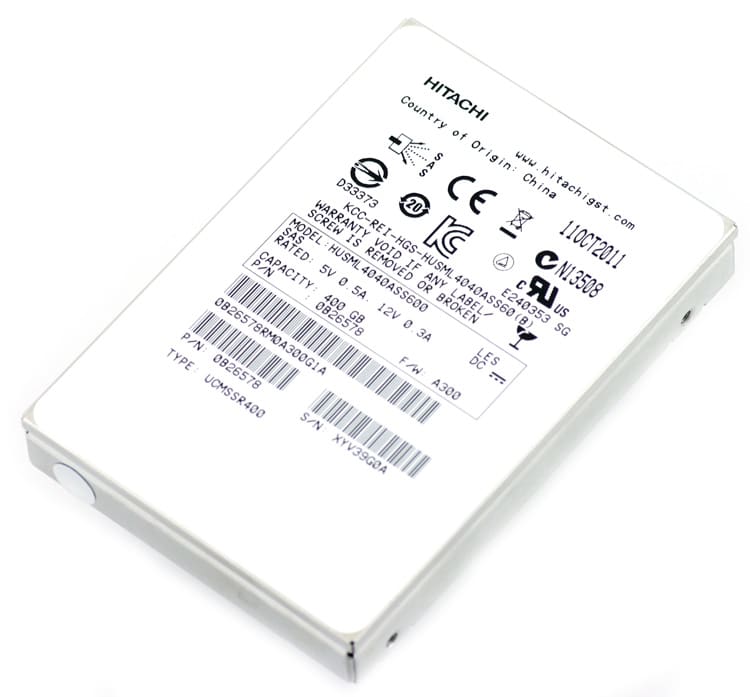
Hitachi offers the 2.5″ Ultrastar SSD400M with a 6.0Gb/s SAS interface and delivers throughput of up to 495 MB/s read, 385 MB/s write, 56,000 random 4K read IOPS and 24,000 random 4K write IOPS. In the enterprise though, it’s not just about speed with SSDs, there’s a larger total cost of ownership measurement at play too. Hitachi quotes 8,360 IOPS/watt, for those factoring in power consumption in their storage buying decision.
The SSD400M isn’t just about performance though, Hitachi’s engineering and qualification leads to an SSD that supremely reliable, with just a .44% annualized failure rate (2 million hour MTBF). From an endurance perspective the drive offers writes up to 7.3PB (400GB capacity), equivalent to 4TB of writers per day for five years, and unlimited reads. Other highlights include the T10 Data Integrity Field (DIF) standard, extended error correction code (ECC), Exclusive-OR (XOR) parity to protect against flash die failure, parity-checked internal data paths without an external write cache, and a power loss data management feature that does not require super-capacitors.
Hitachi offers the SSD400M in 200GB and 400GB capacities with optional TCG self-encryption and are backed by a five year warranty.
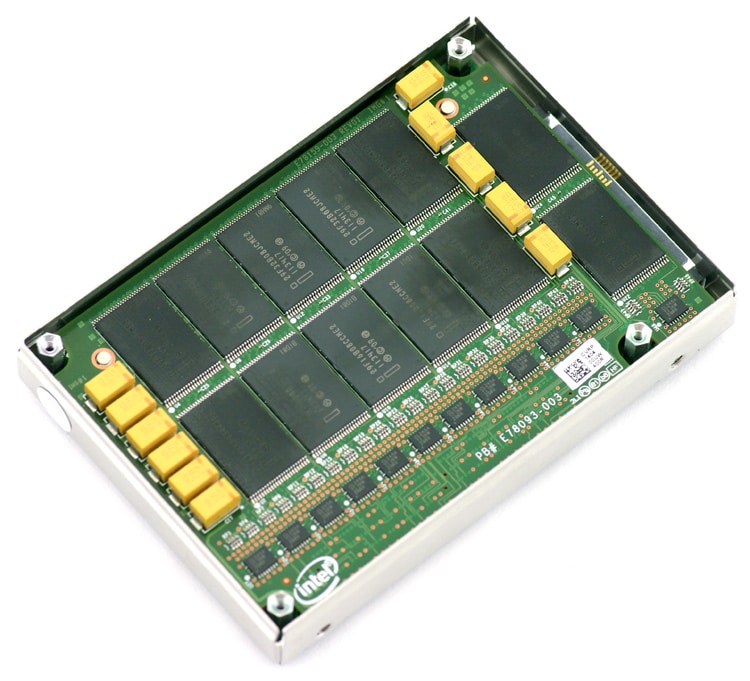
Hitachi Ultrastar SSD400M Specifications:
- Capacities
- 400GB
- HUSML4040ASS600
- HUSML4040ASS601 TCG Encryption
- 200GB
- HUSML4020ASS600
- HUSML4020ASS601 TCG Encryption
- 400GB
- Interface – Dual Port SAS 6Gb/s
- Intel EW29AA31AA1 Controller
- Intel Enterprise Multi-level cell (MLC) 25nm NAND x 39 (624GB+ Raw, 400GB Usable)
- Hynix H5PS1G83EFR 1Gb x 4 DDR2 SDRAM (512MB)
- Form Factor – 2.5-inch, 15mm z-height
- Transfer Performance
- Read Throughput (sequential 64K) 495MB/s Max
- Write Throughput (sequential 64K) 385MB/s Max
- Max Read IOPS (random 4K) 56,000
- Max Write IOPS (random 4K) 24,000
- Endurance (random write)
- 400GB Capacity 7.3PB Max
- 200GB Capacity 3.7PB Max
- Error Rate (non-recoverable, bits read) – 1 in 1016
- MTBF – 2.0 million
- Power Consumption
- Performance Idle 1.7W
- Operating 5.5W typical
- Power consumption efficiency (IOPS/Watt) – 8,360
- Dimensions (width x depth, height mm) – 70.1 x 100.6 x 15
- Weight (max) – 206g (400GB), 221g (200GB)
- Ambient temperature 0 to 60ºC
- Shock (half-sine wave) 1000G (0.5ms), 500G (2ms)
- Vibration (Random G RMS) – 2.16, all axes, 5 to 700 Hz
Design and Disassembly
The Hitachi Ultrastar SSD400M has a smooth stainless steel body, stamped into the precise shape of a 2.5-inch drive with a 15mm height. On top the drive is finalized with a single white sticker that takes up the entire top surface, describing the drive down to the certifications and firmware revision. The bottom includes additional stickers, reiterating the drive’s serial number and part number. The body is rather basic and clean from the outside, with a hefty weight of 205 grams, much of which is related to internal thermal dissipation. With open-air datacenter cooling designs in mind (using outside air instead of cooled or conditioned air) and a general push to reduce energy costs associated with cooling, Hitachi gives the Ultrastar SSD400M a 70C / 158F maximum operating temperature.
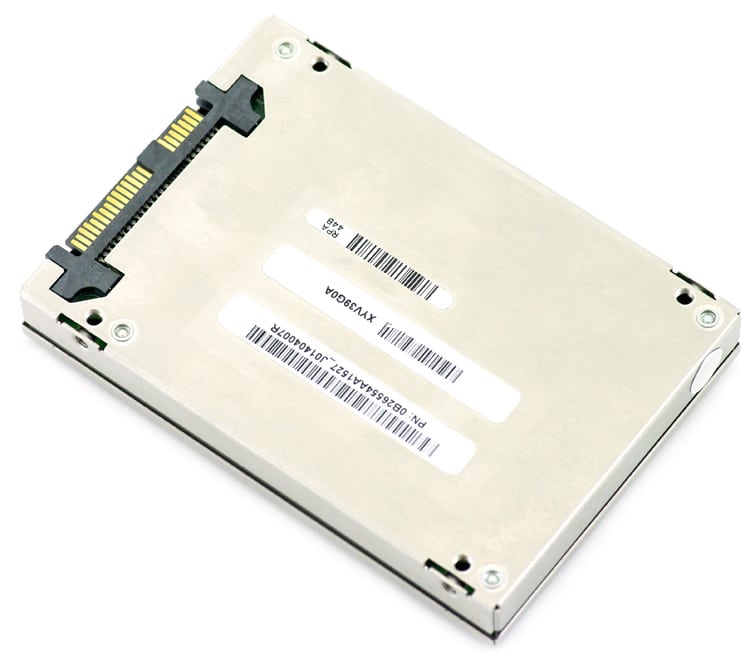
The side profile of the drive clearly shows the two sections that make up the body of the SSD400M. Hitachi uses industry standard screw locations on the side and bottom of the SSD for vertical or horizontal mounting.

The front of the Ultrastar SSD400M includes just the dual-link 6.0Gb/s SAS connector, with no additional connections visible from the exterior of the drive.

Opening up the drive shows off some of the thermal dissipation features of the Ultrastar SSD400M and explains where some of the heft comes from. The top and bottom covers both feature thick thermal pads to draw heat off key components of the SSD. The top cover includes an added heatsink to further increase the amount of energy the case body can absorb off the internal circuit boards that heat up during heavy usage. The design of the SSD is in two parts, with the controller facing inwards between each circuit board. The white pad on the bottom section of the case is designed to pull heat away from the underside of the controller, with the pink thermal pads aimed at the NAND pieces. The body is made as flat as possible on the exterior, to allow for greater surface contact with drive bays to shed thermal energy into the server case and eventually out through forced air cooling.

At the heart of the Hitachi Ultrastar SSD400M is an Intel EW29AA31AA1 processor, using firmware co-developed by both Hitachi and Intel. For cache the SSD400M uses four 128MB Hynix memory pieces, giving it a total of 512MB.
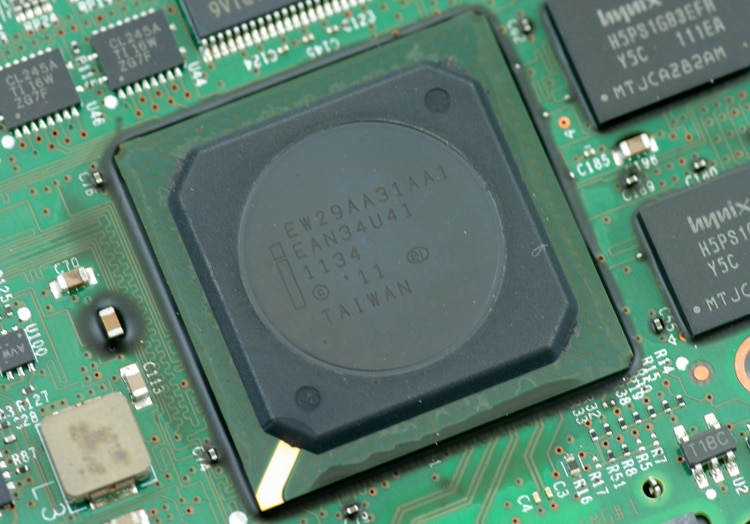
Spread out over both circuit boards are 39 pieces of Intel Enterprise MLC NAND. This gives it a total in excess of 624GB of raw NAND, although only 400GB is usable. Hitachi uses a mixture of different NAND sizes, although the internal usage is not specified. This reserved space is most likely used for background garbage collection, wear-leveling, and handling die-failures in a way that won’t slow down or disable the drive during its lifetime.
The inward-facing sections of the circuit board include the Intel EW29AA31AA1 controller, additional NAND, as well as the long interface that connects both halves of the SSD.
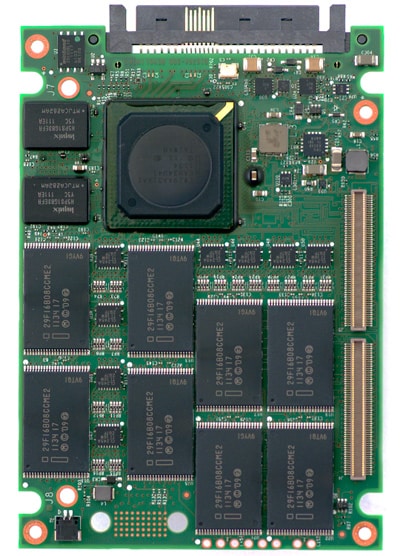
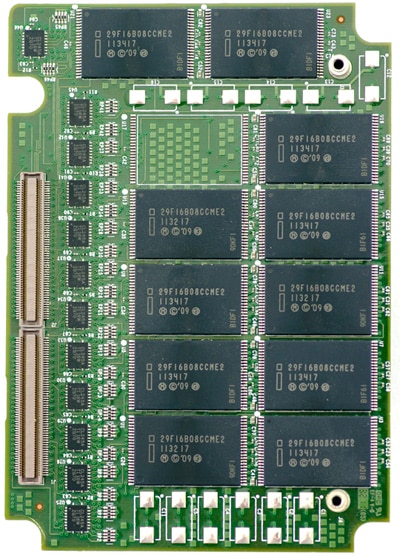
Shown below are the two outside-facing sections of the Hitachi Ultrastar SSD400M. Note that this SSD design doesn’t make use of ultra-capacitors. Instead, Hitachi went with eleven tantalum-based KEMET Organic Capacitors (KO-CAP). These capacitors have a longer lifespan and don’t expand or otherwise degrade as quickly as other alternatives. A similar setup was found on both the consumer-grade Intel SSD 320 and the enterprise-grade Intel SSD 710.
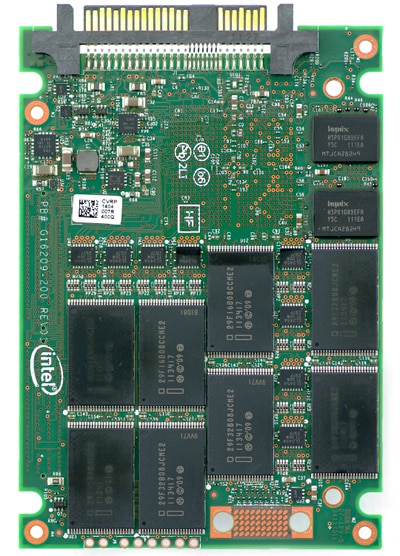
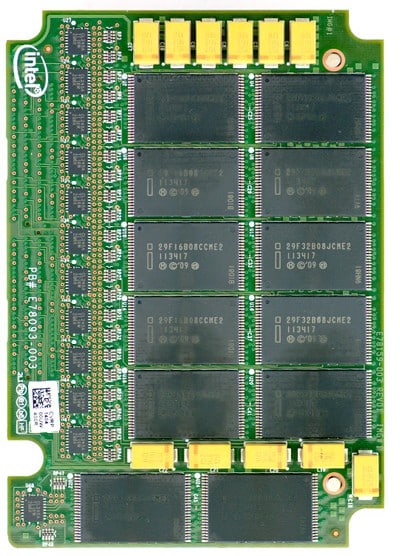
These capacitors give the drive enough time to flush SDRAM to NAND, although the actual amount of holdup time is not specified.
Enterprise Benchmarks
The Hitachi Ultrastar SSD400M uses Intel 25nm eMLC NAND, an Intel EW29AA31AA1 controller and a 6.0Gb/s SAS interface; our review unit is 400GB. The comparables used for this review include the following recently tested enterprise SSDs: Micron P300 (100GB, Marvell 9174, Micron 34nm SLC NAND, SATA), Toshiba MKx001GRZB (400GB, Marvell 9032, Toshiba 32nm SLC NAND, SAS) and the Samsung SM825 (200GB, Samsung S3C29MAX01-Y330, Samsung 30nm eMLC NAND, SATA). All enterprise SSDs are benchmarked on our enterprise testing platform based on a Lenovo ThinkServer RD240. All IOMeter figures are represented as binary figures for MB/s speeds.
Our first test looks at the speed in a sequential write environment with large block transfers. This particular test uses a 2MB transfer size with IOMeter, with 4k sector alignment and measures performance with a queue depth of 4. In this scenario Hitachi claims a maximum read speed of 495MB/s and a write speed of 385MB/s for their 400GB Ultrastar SSD400M.

In our large-block sequential transfer test the Ultrastar SSD400M had read speeds that measured 527MB/s and steady-state write speeds of 385MB/s. The read speed came in above Hitachi’s estimates but the write speed was dead on. These straight-line benchmarks put the SSD400M at the top of our chart.
Moving to a random access profile, but still maintaining a large block transfer size of 2MB, we start to see how performance varies in a multi-user environment. This test keeps the same queue depth level of 4 that we used in the prior sequential transfer benchmark.

With the move to random large-block transfers the Hitachi Ultrastar SSD400M maintained its lead in read speed, measuring 525MB/s. Its steady-state write speeds dropped to 153MB/s, still leading the pack.
Moving to an even smaller random access transfer size of 4K, we get closer to the packet size that might be found in a heavy random access environment such as a server setting with multiple VMs accessing the same array. In the first test we look at expanded 4K read performance and how it scales from a queue depth of 1 to a maximum of 64.
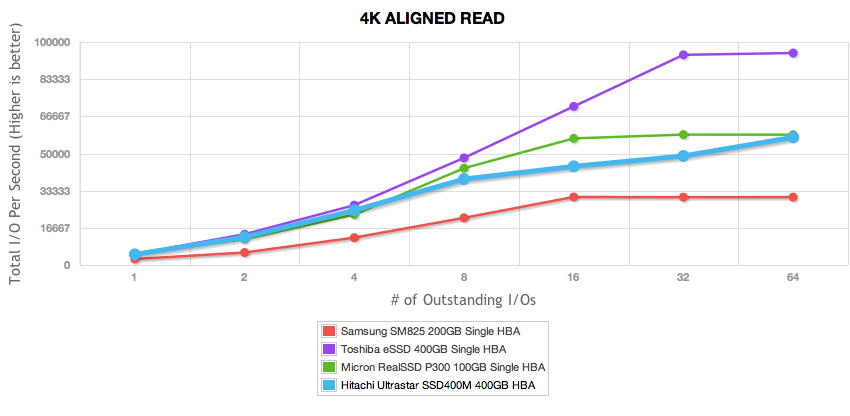
Looking at our random 4K ramped chart, we noted strong performance of the Ultrastar SSD400M, ranking under the Toshiba eSSD with a maximum 4K read speed of 57,261 IOPS at a queue depth of 64.
Our next test looks at 4K random write performance at a static queue depth of 32 and results are recorded and averaged once the drives have reached steady-state. While IOPS performance is a good metric to measure steady-state performance, another key area of interest is around average and peak latency. Higher peak latency figures can mean certain requests can backed up under heavy continuous access.
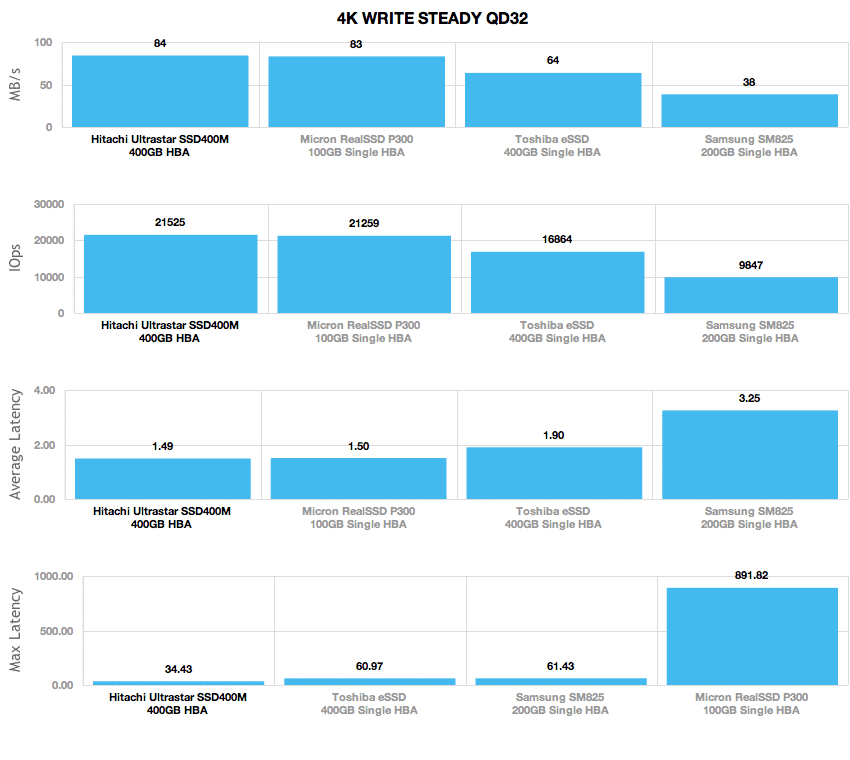
Hitachi claimed a peak 4K random write workload speed of 24,000 IOPS, which we found to be 21,525 IOPS in steady-state in our testing. This speed ranked the highest in our group, above the SLC-based Micron P300. In these conditions the Ultrastar SSD400M measured 84MB/s average with an average response time of 1.49ms. The max response time was probably the most impressive though, coming in at only 34.43ms.
Our last series of synthetic benchmarks compare both enterprise drives in a series of server mixed-workloads with a static queue depth of 32. Like the synthetic benchmarks at the start of this review, these tests are also measured in steady state. Each of our server profile tests has a strong preference towards read activity, ranging from 67% read with our database profile to 100% read in our web server profile.
The first is our database profile, with a 67% read and 33% write workload mix primarily centered on 8K transfer sizes.
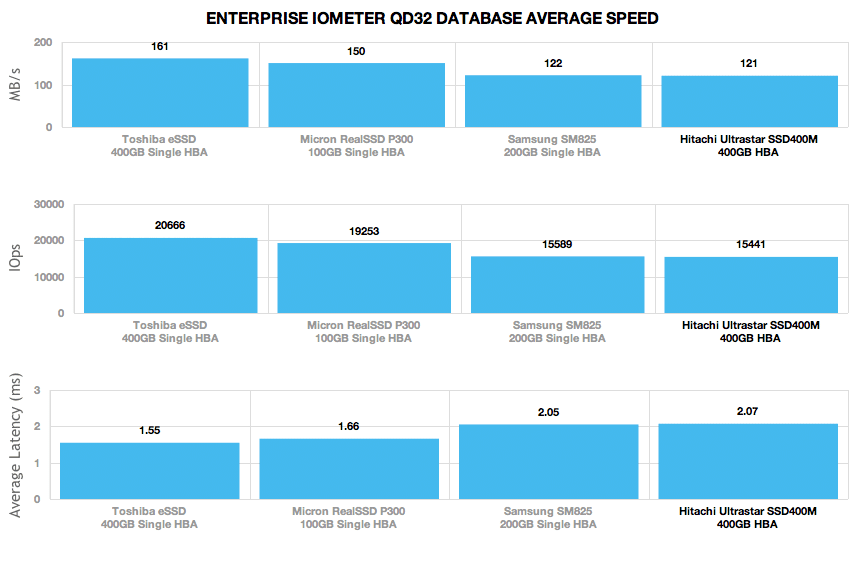
The Hitachi Ultrastar SSD400M leveled off with an average transfer speed of 15,441 IOPS in our Database profile, right alongside the eMLC-powered Samsung SM825. Both of these drives came up under the SLC counterparts; the Toshiba and Micron SSDs.
The next profile looks at a file server, with 80% read and 20% write workload spread out over multiple transfer sizes ranging from 512-byte to 64KB.
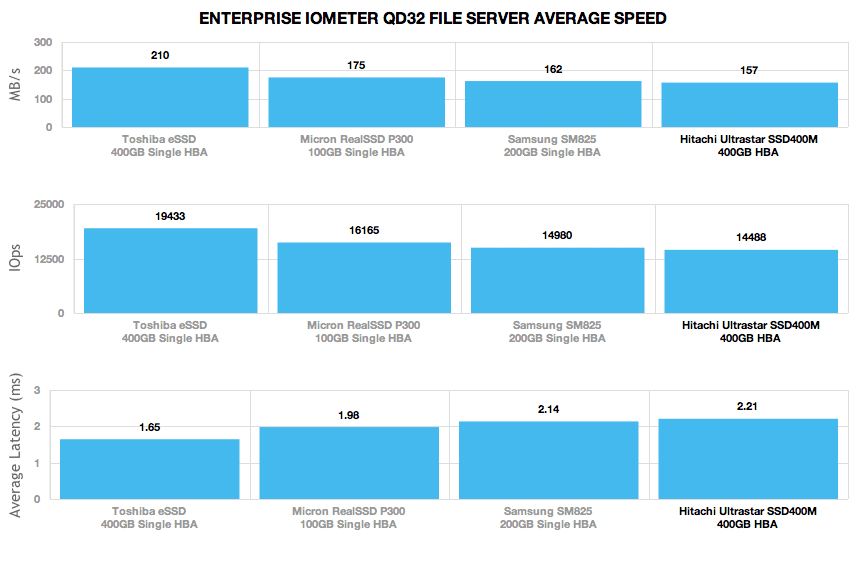
In our file server trace, the Hitachi SSD400M stacked up next to the Samsung SM825, offering an average speed of 14,488 IOPS, compared to 14,980 from the Samsung SM825. The Hitachi came in roughly 25% slower than the Toshiba SLC SSD.
Our web server profile is read-only with a spread of transfer sizes from 512-byte to 512KB.
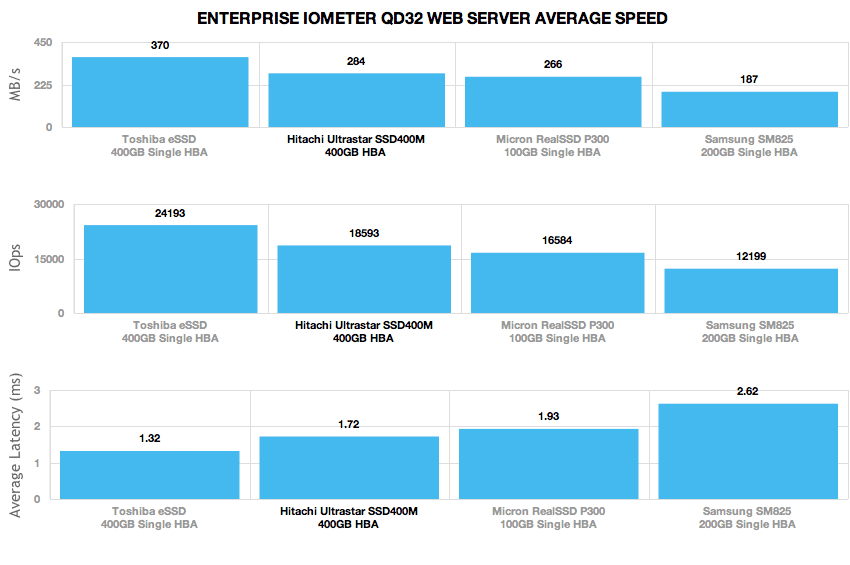
With its fast SAS 6.0Gb/s interface, the Hitachi Ultrastart SSD400M was able to stretch its legs in our Webserver profile, coming in second to the Toshiba SLC SSD, with a speed of 18,593 IOPS. This compared to 24,193 IOPS from the Toshiba eSSD, 16,584 IOPS from the Micron P300, or 12,199 IOPS from the Samsung SM825.
The last profile looks at a workstation, with a 20% write and 80% read mixture using 8K transfers.
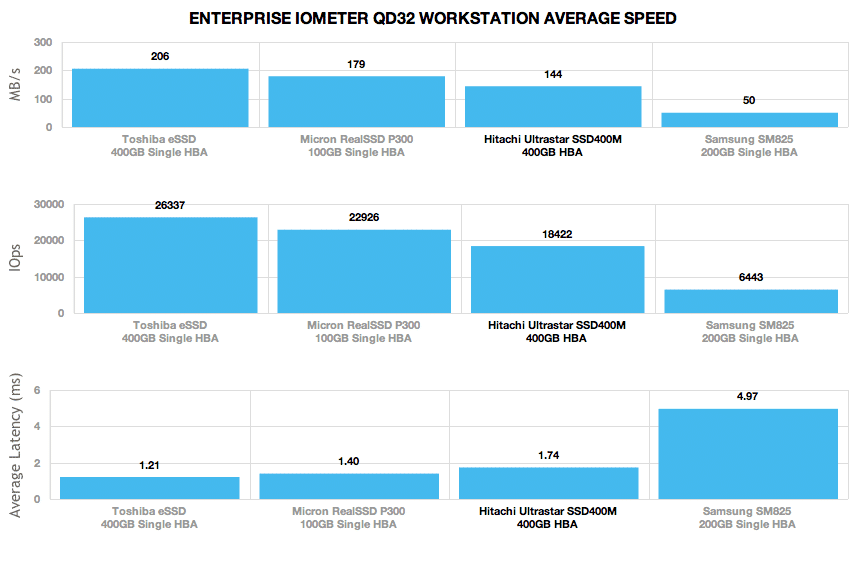
In our Workstation profile the Hitachi SSD400M came in above the Samsung SM825, measuring 18,422 compared to 6,443 IOPS from the SM825. In this profile the Toshiba eSSD measured 26,337 IOPS while the Micron P300 averaged 22,926 IOPS.
Enterprise Power Consumption
When it comes to choosing drives for the datacenter or other densely-packed storage environment, performance isn’t the only metric companies are interested in when looking at SSDs or hard drives. Power consumption can be a huge deal in certain cases, so it makes sense that you would want to know how a drive would perform under a constant workload.
In the Enterprise Power section of this review, we look at each drive under the same conditions we used to test the read and write speeds in earlier. This includes sequential and random 2MB transfers with a queue depth of 4 and small random 4K read and write transfers at a queue depth of 32. As with our previous tests we are measuring all figures in a steady-state to put the drive into its most power-hungry conditions.
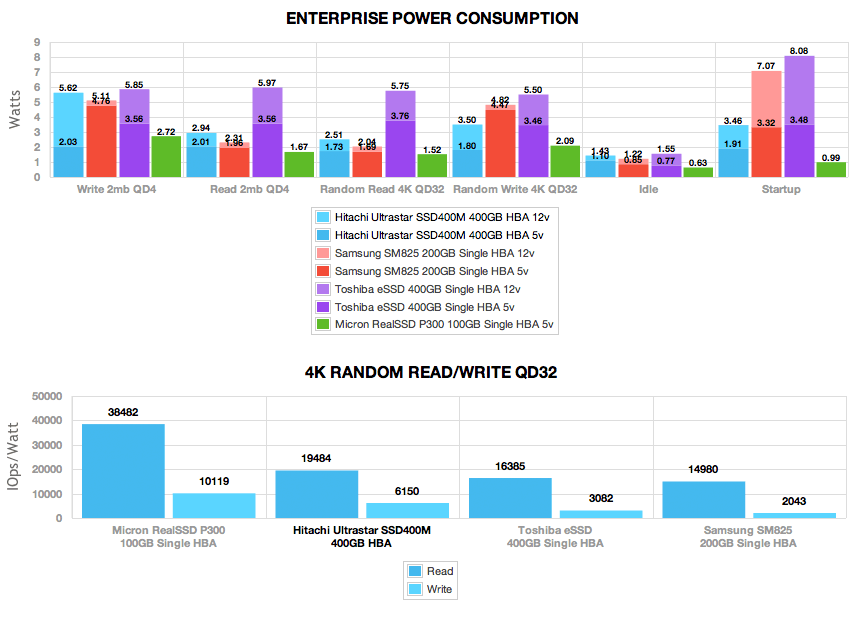
Under all conditions except start-up, the Hitachi Ultrastar SSD400M used 5.62 watts or less. The most power hungry activity for the SSD400M was sequential QD4 2MB write, using 5.62 watts averaged over the duration of the test. Second was random 4K QD32 write, third was sequential QD4 read followed by 4K QD32 steady read coming in fourth. During heavy-write activity the Hitachi Ultrastar SSD400M used just under the amount of power the SAS 6.0Gb/s Toshiba MKx001GRZB required, although power quickly tapered off to much lower levels, near parity with the Micron P300 or Samsung SM825, under read-heavy loads.
A large push for an eMLC SSD in a datacenter environment is around cost per GB and IOPS/Watt. We calculated a figure of 19,484 IOPS/watt in pure random 4K read at a queue depth of 32, dropping to 6,150 IOPS/watt if you instead look at steady 4K random write. This compared to 38,481 IOPS/watt read or 10,119 IOPS/watt write on the SLC Micron P300 or 16,385 IOPS/watt read, 3,082 IOPS/watt write on the SLC Toshiba MKx001GRZB, or 14,980 IOPS/watt read, 2,043 IOPS/watt write on the eMLC Samsung SM825. It really comes down to the needs of the business, finding the best blend of power to performance (or just straight performance) that factors in when buying the SSD or hard drive.
Conclusion
The Hitachi Ultrastar SSD400M features an Intel controller, Intel NAND and custom firmware developed by Hitachi and Intel engineers. The end result is impressive, delivering strong performance in our Enterprise Testing Environment. Based around enterprise MLC or eMLC NAND, the SSD400M offers much of the performance of an SLC-based SSD, but at a much better $/GB or $/IOPS investment. In some cases the Hitachi eMLC SSD was even able to outperform some of its SLC competitors, as was the case in our 4K steady-state benchmark where it measured a chart-topping 21,525 IOPS.
The eMLC Ultrastar SSD400M was able to out-pace both of the SLC SSDs from Micron and Toshiba in write speeds when we looked at single work-load benchmarks. It offered the highest large-block sequential and random transfer speed of 385MB/s and 153MB/s respectively. It also offered the highest 4K steady-state speeds from the group measuring 21,525 IOPS or 84MB/s. Looking at mixed work-load performance, the Hitachi SSD400M offered strong speeds in our read-only Webserver profile as well as very strong performance in our Workstation profile compared to the Samsung SM825.
Even with its strong single work-load numbers, the SSD400M still ranked below the SLC-based Toshiba MKx001GRZB and Micron P300 in our Database and File Server profiles and came in just under the Samsung SM825. This means that in some write-heavy workloads a SLC-SSD is still preferable if performance is the main objective. Depending on how important TCO is the buying decision however, the SSD400M’s eMLC performance may be close enough to warrant consideration.
Setting itself apart from some of the other enterprise drives we have reviewed, Hitachi didn’t go the route of using ultra-capacitors inside the SSD400M, instead opting for KEMET Organic Capacitors. These capacitors aren’t able to give the same amount of hold-up time in the event of a power failure, but their configuration still allows the drive to flush the cache into NAND, so data is not lost in volatile memory stores. These components allow for a much hotter operating temperature of 70C, instead of 55C from the Samsung SM825 or Toshiba MKx001GRZB, both of which use ultra-capacitors. As datacenters look to drive down costs, being able to operate equipment at a higher temperature without increased risk of failure allows systems to be either outside air-cooled or HVAC systems turned to higher ambient temperatures to save on cooling expense.
Pros
- Great 2MB sequential, 2MB random, and 4K random write speeds
- Capable of running at high operating temperatures
- Excellent eMLC SSD IOPS/Watt figures
Cons
- Write speeds drop in mixed work-load scenarios
Bottom Line
With the Ultrastar SSD400M, Hitachi basically writes the how-to guide when it comes to executing with a partner. The Hitachi/Intel jointly developed enterprise SSD is one of the best overall eMLC drives on the market, even topping SLC competitors in some cases like 4K steady state performance. Hitachi also designed the SSD400M with higher heat tolerances than other drives, making them friendly with open-air data centers and generally reducing cooling expense, further improving TCO.
Discuss This Review




 Amazon
Amazon